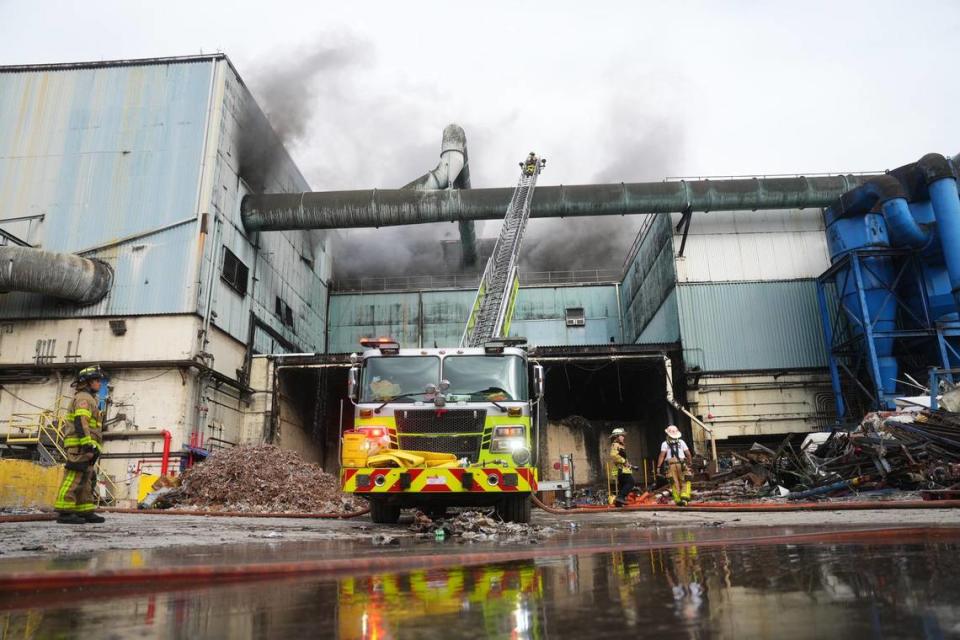Mayor wants Doral trash incinerator to stay closed after fire, rebuild near Everglades
- Oops!Something went wrong.Please try again later.
Miami-Dade’s mayor wants to abandon the county’s shuttered incinerator in Doral and pursue a modern replacement near the Everglades while keeping open the possibility of retaining the trash-burning operation at the current site.
The plan released Friday by Mayor Daniella Levine Cava touches on the county’s various trash challenges, including the proposed $36 yearly hike in garbage fees and how to avoid a development moratorium if local landfills run out of space for more trash.
READ MORE: Miami-Dade’s trash chief resigns after warning that a landfill crisis is coming
For Doral, the memo could be a double-barreled win, at least in the short term. The city urged Levine Cava and commissioners to relocate the privately run incinerator plant, which was burning about half of the garbage collected daily by Miami-Dade trucks before a fire shut it down in February.
Not only is Levine Cava recommending the county-owned plant run by Covanta remain shuttered, she’s urging the commission to back replacing it with a modern facility eight miles northwest from the current one.
The proposed site for a modern incinerator is an airfield off Krome Avenue owned by Miami-Dade, which sits within several miles of the Everglades.
It also is located outside the Urban Development Boundary, the planning divide Levine Cava has fought to keep in place as a check against over-building near the Everglades and farmland. The mayor’s office noted the line wouldn’t have to move for a new incinerator and the other facilities Levine Cava wants to build around to handle other trash needs, such as processing yard waste. Government facilities are already allowed outside the line, known as the “UDB.”
Known as the Opa-Locka West Airport, the idle airfield with two runways is located near where Krome Avenue meets Route 27. While there are some residential neighborhoods nearby, the property sits next to rock quarries.
Residential development expanded near the Doral plant after it was constructed in 1985. Homeowners complain of odor and truck traffic from the facility, which burns trash and converts it into exhaust, energy and ash.
“I’m happy with the memorandum,” said Commissioner Juan Carlos Bermudez, the former Doral mayor who lives near the current plant and has been fighting to move it. “I think it’s a perfect site.”

While Levine Cava said the airport site should be the county’s first choice for a modern incinerator, Miami-Dade would still ask regulators to approve constructing one on the current location in Doral.
The mayor wrote that “given the difficulty of obtaining applicable permits” from the federal Environmental Protection Agency and Florida’s Department of Environmental Protection, Miami-Dade should submit proposals for the locations at the airport, in Doral and a third possibility near the current incinerator in Medley.
READ MORE: Recycling costs just doubled in Miami-Dade. What’s next for your yearly trash fees?
Regulators would consider those proposals in a preliminary review that Levine Cava said could be completed in a year. The other two locations would be available as back-ups if permits can’t be obtained for the airfield site.
Securing permits and then constructing a new incinerator would take about 10 years, she said. Levine Cava said the new plant would use modern technology already at work in Palm Beach County to make the incinerator process more efficient, creating less ash and odor.
“The Administration believes that the County now has a unique opportunity to invest in and modernize a 40-year-old system and turn it into a financially sustainable, environmentally responsible program that will grow with the needs of our community,” she wrote.
In the memo, Levine Cava said the $92 million estimate to repair the burned plant was too high to make sense. Without an incinerator for 10 years or more, Miami-Dade would rely on landfills for disposing of all its trash.
That could be a problem for developers because Florida requires counties to have enough landfill capacity to absorb five years worth of population growth in order to build new homes.
Levine Cava said she’s considering a plan to transport some garbage out of the county by cargo train, and wants to expand existing contracts for landfills in Central Florida.
She’s also recommending Miami-Dade commissioners approve expansion of the North Dade landfill off Northwest 47th Avenue outside Miami Gardens before it runs out of space in 2026. Already 135 feet tall, Levine Cava said she wants the landfill to grow taller but not expand its footprint.
Levine Cava also wants commissioners to study how to expand the county’s second landfill, off Southwest 240th Street near Homestead known as “Mount Trashmore.”
Commissioners have an immediate decision to make on the county’s trash system, with Levine Cava urging passage of a $36 increase in the $509 fee more than 300,000 households pay for county trash pick-up services. The money is needed to pay for higher recycling costs and growing expenses related to garbage pick-up and disposal.
Levine Cava said she wants to end the fees in 2025, with Miami-Dade creating a new property tax to fund trash expenses instead that would vary based on the value of the real estate receiving the service. Commissioners would need to approve the new tax ahead of the 2025 fiscal year, which begins Oct. 1, 2024.
The vote on the higher trash fee is scheduled for Sept. 6, when commissioners would also decide whether to accept Levine Cava’s memo on long-term plans for the incinerator.

